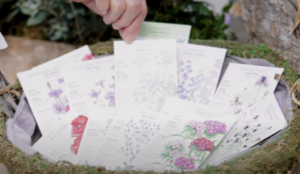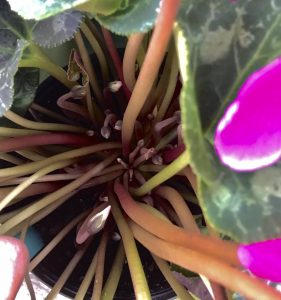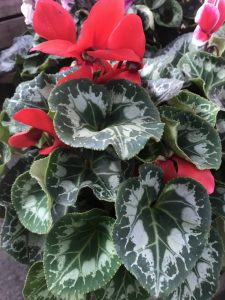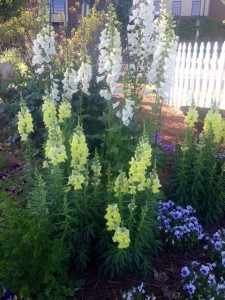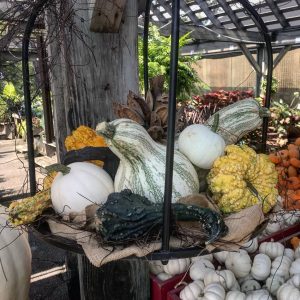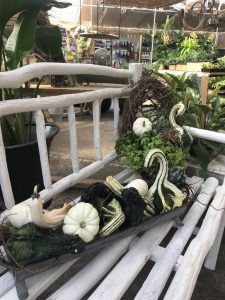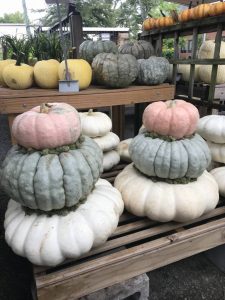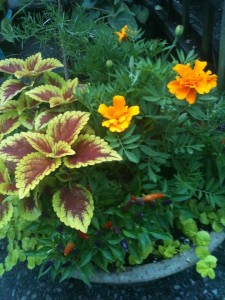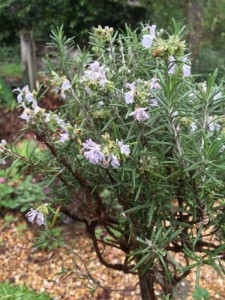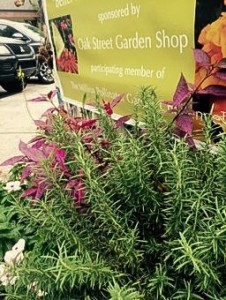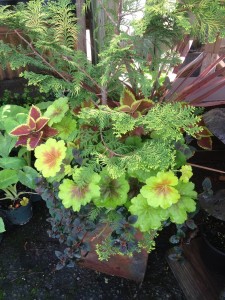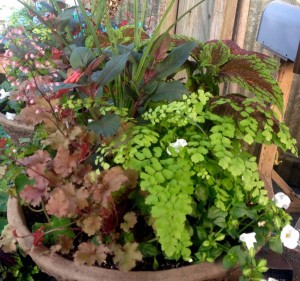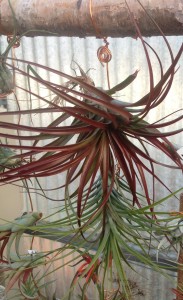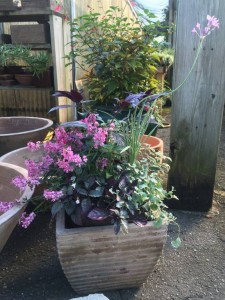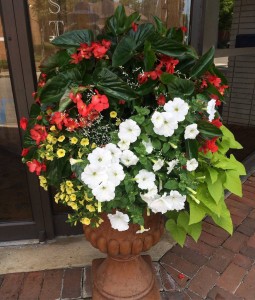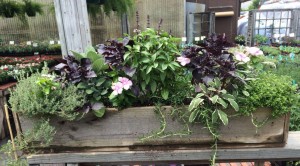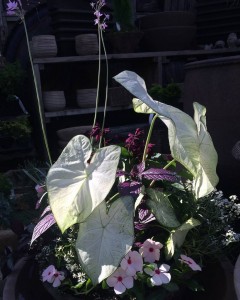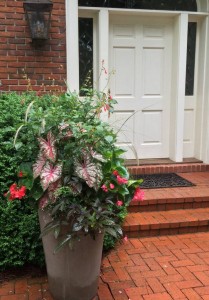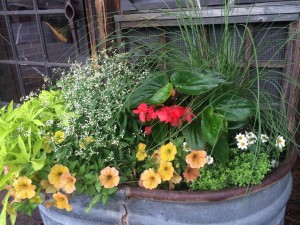Faux Pumpkins Offer Some Real Gorgeous Fall Decor!
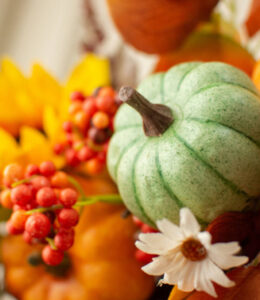
Faux Pumpkin decor
Fall is almost here (wish it would hurry up) and we’re all ready to finally start putting up our fall decor! And nothing says fall quite like pumpkins. We have our faux pumpkins in stock and I’ve already made a few arrangements that I’m very excited to share.
Our variety this year includes some cool tones to test out with your fall garden. Arrange them individually, group them, or incorporate them into decorative baskets.
I’ve paired some with succulents and dark green plants to complement the colors and just love how they turned out! If you want some color contrast instead, I really like the look of them with grape vine reeds, faux bittersweet and artichoke.
Style them with live plants and add them to your fall garden, or pair them with faux elements to make a cute seasonal table setting! As always, we love to see how creative you guys are with these. Come visit and pick up your own pumpkin then tag us on Instagram and Facebook so we can see your creations!
– Kris
Cosmos & Marigolds: Go-To Fall Blooms
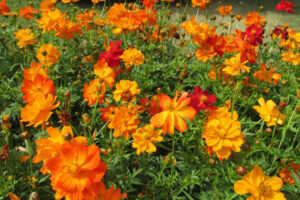
Cosmo flowers in a field
Ready to give your garden a fall facelift? Well, you’re in luck. The crew and I recently did a video on these fall beauties – they are not only super easy to care of, but are absolute CHAMPS in pots and garden beds alike. Here’s a little more information and a few tips to jazz up your garden this season.
Cosmos: Bringing Mexico’s Magic Right to Your Backyard
Okay, so let’s talk cosmos. These beauties are native to the meadows and scrubs of Mexico, but they’re now flaunting their vibrant colors all over South and Central America. The colors range from sunny yellows and oranges to dreamy pinks, whites, and even a deep maroon – they’ve got it all.
Po-tip? Get them some good sunshine and make sure the soil drains well. And DO NOT FORGET to snip off those old blooms. It keeps them looking fresh and encourages more of those lovely petals to pop up. I know it’s a little bit of work, but trust me; you’ll thank me later.
Marigolds: The Jack of All Trades in the Garden
And then, it’s over to the marigolds. These little sunbursts come in all sorts of shades – we’re talking orange, red, gold, and even white. And they really do light up just about any space they’re in. Whether in pots or planted in the ground, they aren’t fussy, just make sure they don’t sit in waterlogged soil.
DO deadhead your marigolds, like with cosmos. When you remove spent blooms, the plant will produce more buds, and boom – more color.
If you don’t want to deadhead your marigolds, it’s fine – it doesn’t necessarily hurt anything, but I don’t believe you’re getting as much out of the plant that you could. Up to you. (But I tell everyone to do it, so there you go.)
CHECK OUT OUR VIDEO ON COSMOS & MARIGOLDS!
All About Cosmos and Marigolds This Fall
As summer waves goodbye and fall starts to roll in, we can’t help but fall head over heels for the warmth and color that cosmos and marigolds bring to the garden. Whether you are newbie gardener or a seasoned pro, marigolds and cosmos won’t let you down. Cheers to a colorful fall! ![]()
![]()
– Kris
Staying Safe in the Garden: Beat the Heat

Hot Weather Clip Art drawing (Vector cliparts) clipart,hot,weather,sun
So, with the sun cranking up the heat and heat advisories doing their rounds in the Southeast, I wanted to talk about keeping safe while working outdoors.
Many dermatologists insist on proper sun protection. The sun’s ultraviolet (UV) rays can cause lasting damage to your skin, ranging from sunburn to more serious conditions. Sunscreen is your best friend here. I make it a habit to apply sunscreen generously and frequently, even if I’m working in the shade.
Let’s talk clothes, folks. Light long-sleeved shirts, those cool wide-brimmed hats, and sassy sunglasses – they’re not just for looking cute. I like to pair a breathable long sleeve shirt with light pants and a wide-brimmed hat to keep my sun exposure minimal and protect my skin while keeping cool.
Also, know that it is super easy to get dehydrated fast while in your garden. The sun, the heat, and physical activity can and will drain you fast. I keep a water bottle nearby all the time. And let’s be honest, who doesn’t love those refreshing breaks to sip and soak in the garden view?
By the way, if you’re more of a visual learner like me, I’ve got a cool video to share. Check out my insights on staying safe in the garden!
Remember, staying cool in the garden isn’t just about the plants – it’s about you too. And trust me, that balance between creating a gorgeous garden and looking out for yourself? It’s the real craft sometimes. So get out there and savor your green haven while staying sun-smart.
– Kris
Grammatophyllum: Be the Tiger Queen (or King) of Your Garden
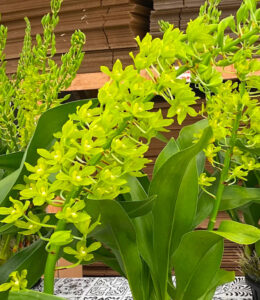
grammatophyllum orchid
Grammatophyllum are a favorite here at Oak Street Garden Shop! If you’re seeking a distinctive and tropical plant for your green space, I highly recommend these orchids. These are some of the largest orchids you can buy and they do well in warm and slightly humid climates like what we have here in Birmingham.
Grammatophyllum, also known as Tiger Orchids, are native to the Philippines and Southeast Asian countries. During the summer, Grammatophyllum orchids thrive outdoors and in greenhouses in warm and humid weather. To ensure their well-being, provide them with filtered shade and lots of moisture.
As the seasons transition to winter, bring them indoors but be sure to ease up on their moisture. They do well on pebble trays that add moisture to the air around them. They also prefer fish emulsion and more organic fertilizers.
Here’s a fun fact: In 1851, at the great exhibition at Hyde Park in London, a Grammatophyllum weighed in at 2 tons! Don’t worry, most don’t get that large. What we can say with certainty is that these beauties look great just about anywhere, and we love to see what you do with them.
Learn even more!
We’re Here, and on YouTube Too!
Many of you might know by now that we’ve taken the dive into YouTube, with some help from Harry Long and his excellent marketing firm 81Shop. He’s enabled us to have quite a few videos out there for you to check out.
We have tried to have a bit of everything, from the “Plant of the Week” to planting tips, to design ideas. We hope you’ll take a look and Subscribe!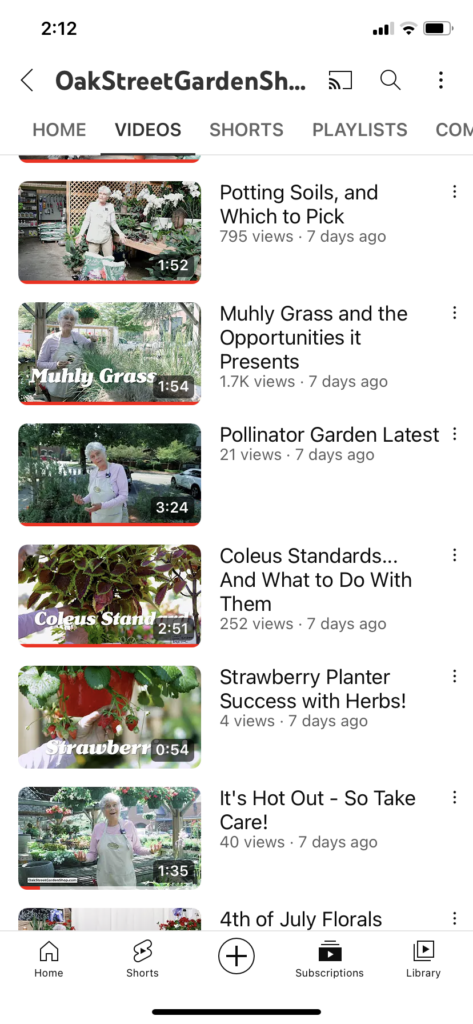
Here are a few screen shots from our channel. If you’re interested you can get there by clicking on the YouTube button on the home page here on our website.
Thanks for watching!
By Kris Blevons
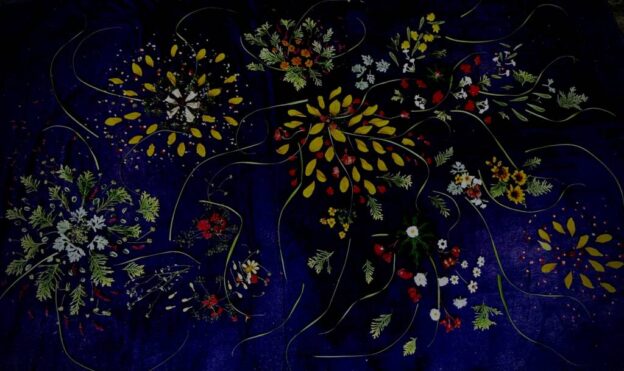
Our Floral “Fireworks” for the 4th!

 Our 2023 Floral Fireworks creation, using petals, leaves and grasses from the garden. Nature’s bounty celebrated!
Our 2023 Floral Fireworks creation, using petals, leaves and grasses from the garden. Nature’s bounty celebrated!
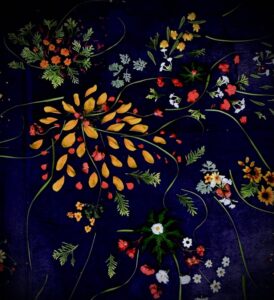

Myrtle Topiaries

Myrtle topiaries in pretty pots…
Whenever we can find myrtle topiaries we try to get plenty, as they’re not always available. Many moons ago we had a small specialty grower in Georgia who supplied us with these pretty plants regularly. She spoiled us! When she retired, we found another supplier and still carry these special plants. They now come to us in 5” pots, perfect for dropping into your favorite cachepot.
Myrtle, myrtus communis, was an integral part of Roman gardens and is widespread in Mediterranean regions where it is cultivated as a large ornamental shrub. The topiaries we carry are a dwarf myrtle, Myrtus communis ‘Compacta’, and are happiest grown outside in containers through the summer in a sunny to partly sunny spot. Kept watered regularly, the long, hot summers will bring on small flower buds that open to white blooms. With fall and cooler temperatures, it’s best to trim it for the winter and place it indoors in a bright, sunny room. The glossy and pleasantly aromatic leaves are a beautiful shade of green, and the entire plant takes to shaping very well – simply trim it when it becomes shaggy.

myrtle has glossy, aromatic leaves…
Myrtle Topiary Care
Give them plenty of light – they prefer to be in sun in their native habitat, so a dark room indoor won’t give them the light they need. If you know you don’t have enough light where you really want them (on a mantel in a dark room) you may need to swap them out periodically, placing them in a sunny spot to grow well, then moving them back and forth.
Water! It’s important not to let them dry out, but be careful they’re not sitting in water too. If your topiary is root bound, it will need more diligent watering. Repot it in the spring if, when you pull it out of the pot, you see a mass of roots. Myrtle is a plant that will not recover if left too long between watering.
During the growing season, March through September, fertilize your topiaries with a 20-20-20 fertilizer every couple of weeks. When you bring it in for the winter, cut back feeding to once a month.
When you trim your topiary, it’s best not to shear the tips. Try to cut back a bit into the plant. Remember wherever you cut, two stems will grow, creating a nice full head of foliage.
Note: We get many calls from people from around the country asking us to ship our myrtle topiaries when we have them in stock. Unfortunately we are not set up to ship at this time.
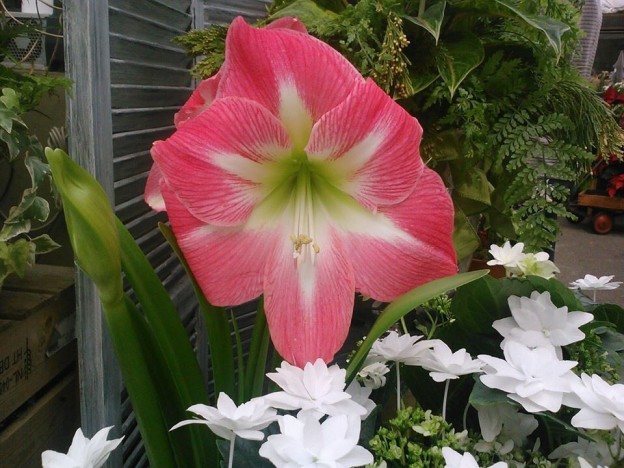
Amaryllis – Beauty In A Bulb
Amaryllis, unquestionably, are one of the most dramatic and elegant of flowers. That bold, beautiful blooms of all colors and sizes can emerge from such a drab, unassuming brown bulb is amazing. They are truly a wonder of nature!
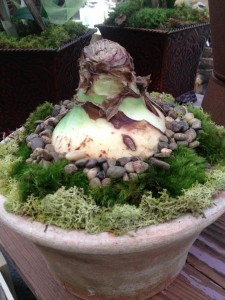
Decorative moss and pebbles dress up this amaryllis bulb…

Amaryllis in the greenhouse…
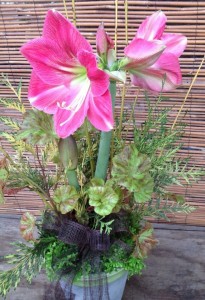
Amaryllis arrangement…
So, you want to purchase an amaryllis bulb (or more than one) for yourself or as gifts for friends? First, you need to know that the size of the bulb corresponds to the size and amount of blooms. Their sizes range from “miniature” amaryllis bulbs to jumbo amaryllis and there are midsize bulbs as well.
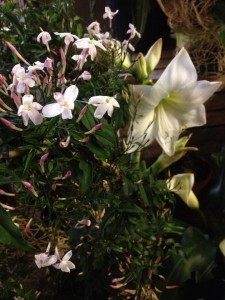
Large blooms of this amaryllis offer a contrast to the fragrant jasmine…
Beware of gift boxes and bags already prepackaged. I’ve stopped carrying them because, inevitably, the bulb begins to grow in the box prior to purchase. Believe me, there’s nothing sadder than an amaryllis, stem bent toward the light, growing sideways out of a box. It’s just not right!
Potting them up is quite simple. Find a pot that is no more than an inch or so wider than the bulb and fill it with good quality potting soil (We use Fafard.) about half way up the pot. Next, position the bulb on the soil, pushing the roots firmly in place. The “shoulder”, or widest portion of the bulb, should be above the soil. Fill in around the bulb, push down gently, and water with some of the remaining manure tea.
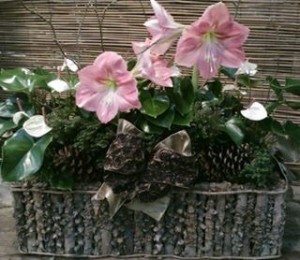
The hardest part is the wait for the bud to begin to emerge. It may take just a few days in a warm, sunny room, but it can just as easily take longer. Amaryllis don’t always cooperate with our timetables. Take a look at this “Holiday Flowers” post from last year and you’ll see what I mean. When you do see new growth starting to emerge, begin to water just so the soil stays slightly moist and watch the magic happen! You can also “dress up” the top of the soil with decorative moss or pebbles. 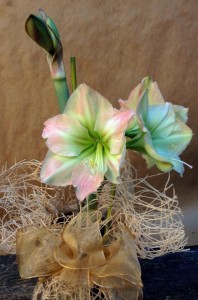
In bloom amaryllis can get quite tall and will usually benefit from some type of staking. In addition to simple bamboo stakes, stems of red and yellow twig dogwood, birch, curly willow, or branches from your landscape can be used. Insert the staking material at the edge of the bulb and tie it with raffia or ribbon.
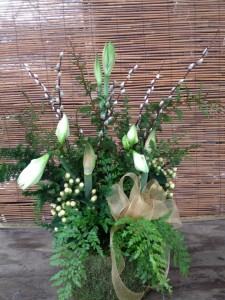
Amaryllis, budded, with ferns, and stems of pussywillow…
The pictures here show what we’ve done in the past using amaryllis. They make wonderful presents during the holiday season and simply watching the bloom stalk grow taller and the enormous buds begin to open is a gift in itself!
There’s also a video we’ve done on amaryllis available to watch on the Oak Street Garden Shop YouTube channel. If you enjoy it, subscribe for more!
In addition to bulbs that are available for you to plant, we also will be receiving many amaryllis already potted up from our growers. So, if you’re in the Birmingham area, there’s no excuse not to have one of these holiday favorites!
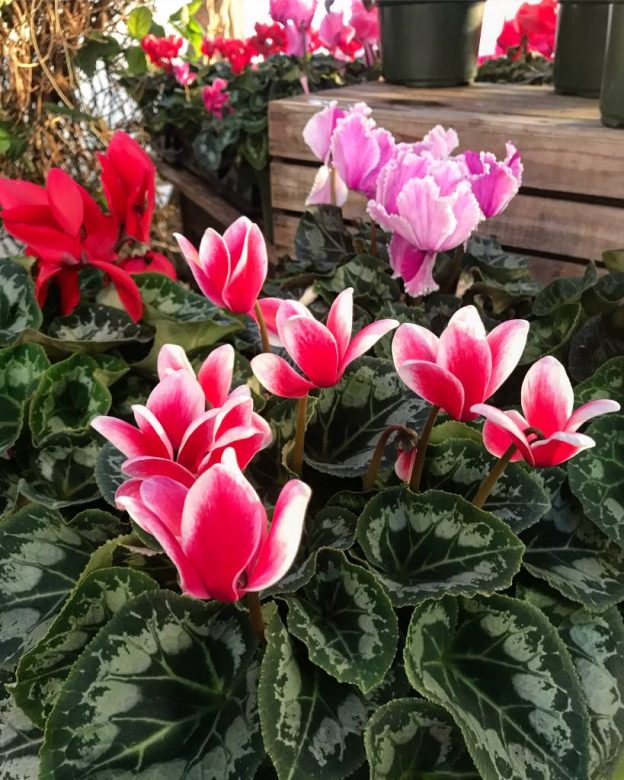
Cyclamen – Winter Beauties For Your Home
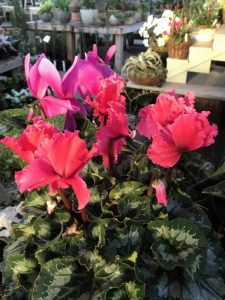 Florist cyclamen, with their beautifully patterned leaves and pretty blooms, are one of the best flowering houseplants for winter color, and they’re usually available any time from November through late February, or until the weather warms. In nature hardy cyclamen grow naturally in cool, humid environments, and tubers gradually go through cycles of growth and dormancy.
Florist cyclamen, with their beautifully patterned leaves and pretty blooms, are one of the best flowering houseplants for winter color, and they’re usually available any time from November through late February, or until the weather warms. In nature hardy cyclamen grow naturally in cool, humid environments, and tubers gradually go through cycles of growth and dormancy.
In your home florist cyclamen prefer a bright spot with temperatures around 68 degrees during the day and preferably a bit cooler at night. If your room is very warm, or you overwater, the leaves will begin to yellow and the flowers won’t last long.
Once you’ve found the right placement, water sparingly, but don’t let it get so dry that the leaves wilt. It’s best to water cyclamen from the bottom. Let it sit in a tray of water for about 30 minutes or until the soil is moist, then repeat when the soil begins to dry.
As flowers fade, keep them deadheaded to prolong the bloom. Usually there are tiny buds down in the very center of the plant, much like violets and another reason to water from the bottom. If your cyclamen is happy the buds will continue to offer flowers until it’s time to rest.
Eventually your cyclamen will bloom out and begin to go dormant. You’ll know this is happening because the leaves will yellow and eventually all disappear. This is normal, and hardy cyclamen in the garden do this naturally as the plant goes into a rest period through the summer months. In your home, stop watering and place the plant in a cool dark place.
It will look like your plant is dying as the leaves turn yellow one by one. After a period of some months of dormancy with little to no water, it will be time to bring it back into more light and begin to water again. Water it thoroughly until the soil is completely saturated, then resume normal care. You’ll begin to see leaves reappear, and buds should follow.
Cyclamen are a little more demanding in their water and light needs, but they more than reward you if you persist!
****If the buds on your cyclamen don’t open, you might have cyclamen mites. These tiny insects lay their eggs around the buds. The larva enters the bud after it hatches and suck sap from unopened petals. Unfortunately buds infested with mites won’t open and since these pests are difficult to manage its best to discard infested plants.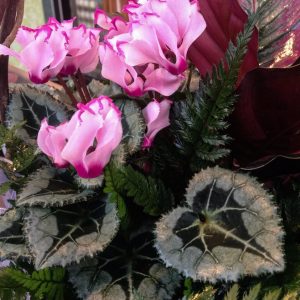
If you think your cyclamen has mites and you’d like to treat them, the information below is from the University of Kentucky:
“Often, it is better to discard infested plants than to attempt to control the problem with pesticides. If chemical control is attempted, isolate the infested plants to reduce potential spread of the mites. Spraying the plants with…insecticidal soap can provide effective control, especially after pruning back the growth. Three to four applications should be made at 3 to 5 day intervals with insecticidal soap. Direct applications at both the lower and upper leaf surfaces.”
By Kris Blevons

Foxglove – Plant It This Fall For A Beautiful Spring Display!
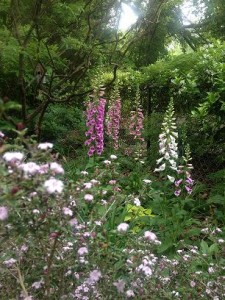
Foxglove…
Foxglove, Digitalis purpurea, is the quintessential English garden flower. It’s beauty has graced landscapes of great gardeners for hundreds of years, as well as those of more modest means.
Considered a biennial, foxglove is purchased as small transplants in the fall, growing through the winter and reaching their peak flowering time as the roses begin to bloom here in Birmingham.
Plant them in a partially sunny spot, ideally one that will receive some shade in the afternoon. This is especially helpful as temperature begin to rise in the spring and will help them bloom longer. Be sure your soil is loose, and add soil conditioner, shredded leaves, or compost if necessary. Mulch them with shredded pine bark or pinestraw after planting and keep them watered during dry spells.

Foxglove and roses in my early spring garden
Foxglove look particularly lovely against an evergreen backdrop or a wall of some sort. Combined with other spring annuals and roses, they are reminiscent of a classic cottage garden.
Once they’re through blooming, plants can be left standing to drop seed, (You’ll see baby plants the following summer if this happens.) but they do get a bit bedraggled looking at this point, and I prefer to pull them out, replanting each fall.
Look for a video on our YouTube channel on foxglove in October, 2022. We’ll try to have other informative videos as well, so if you like them, subscribe!
By Kris Blevons
Fall Planting Tips To Creating A Great Spring Garden
Fall Planting Tips To Create A Great Spring Garden:
-
Amend your soil. You might think since you followed our advice and added soil conditioner, PlantTone, or compost to your beds last spring you’re done. Not so fast! High temperatures break down soil amendments quickly, and plants take up nutrients. Continue adding to your soil every season. Healthy, loose soils create healthy plants. (Instead of putting fallen leaves to the curb, start a compost pile with them, or run over them with your lawn mower and throw them in your beds. They’ll decompose and add to your soil’s structure and health.)
- After you get your plants home, be sure to keep them watered, especially if you can’t plant them right away. We water small transplants in 4″ pots and cell packs at least once a day, especially if it’s hot and sunny. Of course, less water is required in cloudy, cool conditions. Right before you plant them, be sure they’re moist.
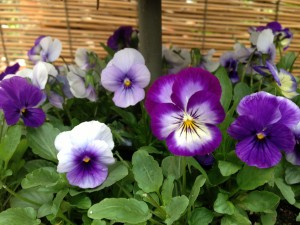
- Early in the season while the soil is still warm, you can still plant with Osmocote. However, later in the winter months, use Calcium Nitrate to feed your plants, especially if the foliage of your pansies turns a reddish color. Remember, you’re planting for spring color, though on warm days through the winter you should also have some blooms.
- Water your bed thoroughly after planting, and keep it watered while your transplants are getting their feet settled in their new home. Take care not to overwater, though, especially as the temperatures cool down going into the winter months.
- Mulch your beds with shredded mulch or pine straw to keep soil temperature around the roots as warm as possible.
- Deadhead your pansies and violas! I can’t stress enough how important this is. A pansy that you leave a dead bloom on will form a seed there, instead of putting that energy into more flowers. Make a practice to walk through your garden at least once a week, taking a good look at your plants and deadheading faded blooms. If you’ve missed some, you’ll see the seed pod beginning to form. Pinch any and all off! This will go a long way toward keeping your pansies happy!
Have you seen any of the videos we’ve been posting on our FB and Instagram? If you follow us, maybe you have! If you’re not on social media though, you can also find us on our YouTube Channel. Yes, we have a YouTube channel! Just search for Oak Street Garden Shop, and subscribe if you’d like to see more!
By Kris Blevons
– Posted using BlogPress from my iPhone
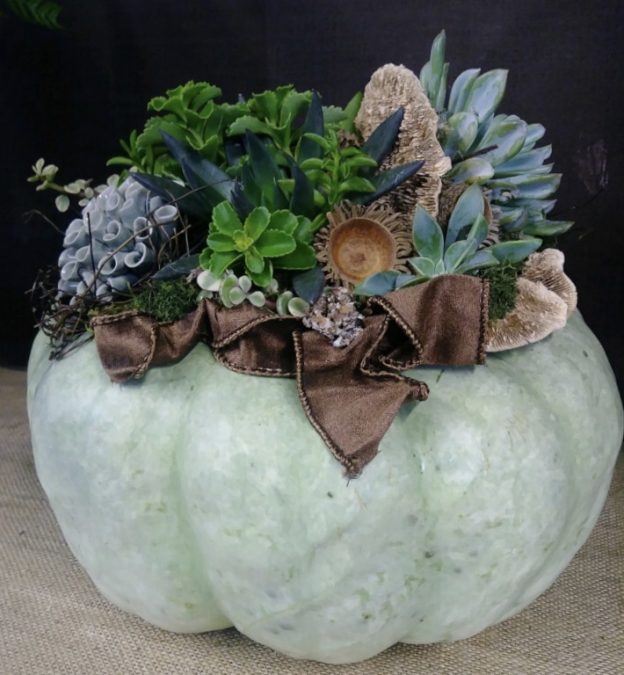
Fall Inspiration With Pumpkins And Gourds As A New Season Begins
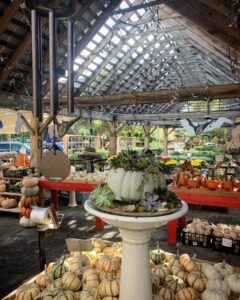
That’s when we look at each other and say, “We are so lucky to work outside!” We’ve been looking forward to this, and with the arrival of pumpkins, gourds, and fall decorating staples, we are willing the temperatures to fall.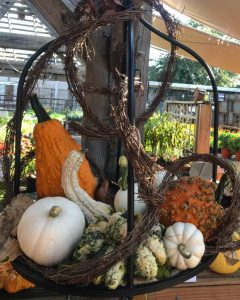
The hanging “platforms” shown here a couple years ago were used to create a pumpkin/gourd garden in the air.
We envisioned them as an elevated centerpiece for a party, hanging on a screened-in or covered porch area, or simply set in the perfect place to spotlight the abundance of the season.
There are so many varied sizes, shapes and textures of gourds and pumpkins that can be used alone or with plants for centerpieces and gifts.
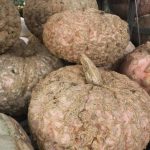
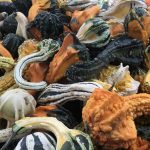



Simply gather those you like, being sure to get enough of a selection. With so many to choose from, it’s more than likely you’ll gather more than you need!
We use all manner of organic materials to complement them and have a customer who brings us beautiful fallen acorns to use. We add lichen, mosses, branches, burlap, and ribbon too, depending on the container.
Our succulent topped pumpkins will be making a return for the season as well. Those shown here are some from past seasons. If you’re in the area and would like one, give us a call!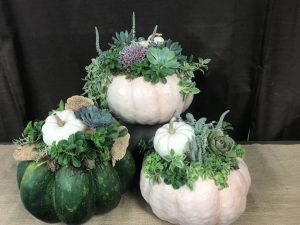
Stacking pumpkins is a popular way to display them in front of your house.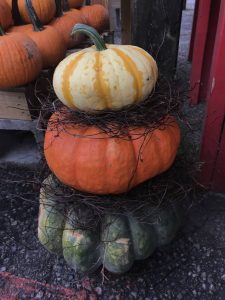
Simply find two or three that are different colors (or the same!), stack them as is or add another element like moss between them, and, voila, you have a beautiful entrance for the season.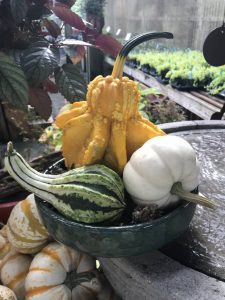
We are just beginning to work with the small gourds that can be grouped together in containers for tablescapes, on bedside tables in guest rooms, or on coffee tables. Make a nest of angelvine or moss and position them however you like them.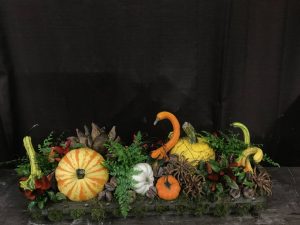
Our pumpkin supplier comes weekly with the best assortments hand picked for us. We hope you’ll stop in if you’re in the area! Our pumpkins will be arriving soon!
If you follow us on Instagram or Facebook you’ve no doubt seen the videos we’ve been doing, or we hope you have! Follow us there or you can also subscribe to our YouTube Channel – it’s under Oak Street Garden Shop. Thanks for watching!
By Kris Blevons
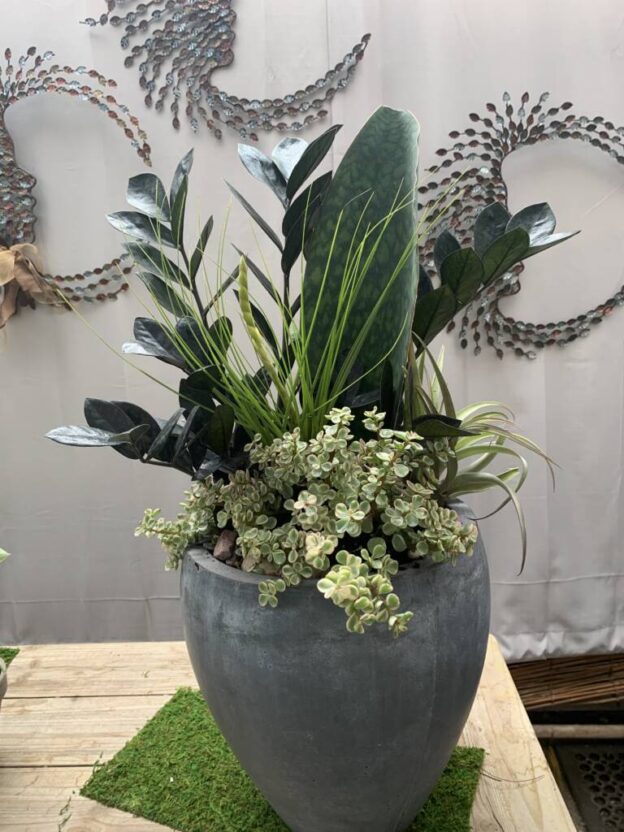
Whale Fin Sansevieria – In Stock Now!
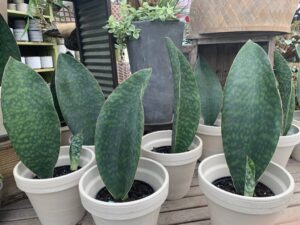 You might be familiar with mother-in-law tongues, or snake plants. We love these easy to care for plants and recently received a member of the family that looks quite a bit different!
You might be familiar with mother-in-law tongues, or snake plants. We love these easy to care for plants and recently received a member of the family that looks quite a bit different!
This very distinctive plant is aptly named whale, or shark fin, snake plant. Sansevieria masoniana’s native habitat is the Congo region of Central Africa, which give us a clue as to how to take care of it. Though, to be truthful, their care is similar to any snake plant you might have owned.
They like bright light, though they will tolerate lower levels. They are also happiest when left to go dry between watering. Too much water is never good for this family of plants and can lead to root rot. Remember, they’re from central Africa and go for long periods of time in their native habitat with little to no water.
If cared for properly they’ll grow up to about 3’ or so and their leaves will reach an impressive size. Because their leaves grow so large, it’s a great idea to wipe them off with a damp cloth to remove dust at least once a month and this keeps them looking their best too.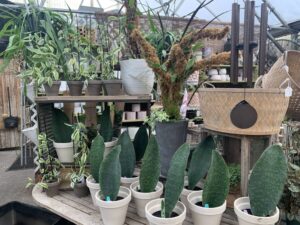
If you have any insect issues (sometimes cottony, white mealy bugs and tiny spider mites can be a problem), using a bit of Neem oil on a cloth will eradicate them. Keep a close eye on your plant to ward off any future issues.
If you’re in the neighborhood, stop in and take a look at these rare and wonderful plants. You might just have to have one for yourself!
If you follow us on Instagram or FB, you might be seeing some of the videos we’re posting. We recently posted one on the whale fin Sansevieria! If social media isn’t your thing, we also have a YouTube Channel (Really!). Subscribe if you’re so inclined. We’re doing our best to put out interesting and informative videos.
By Kris Blevons
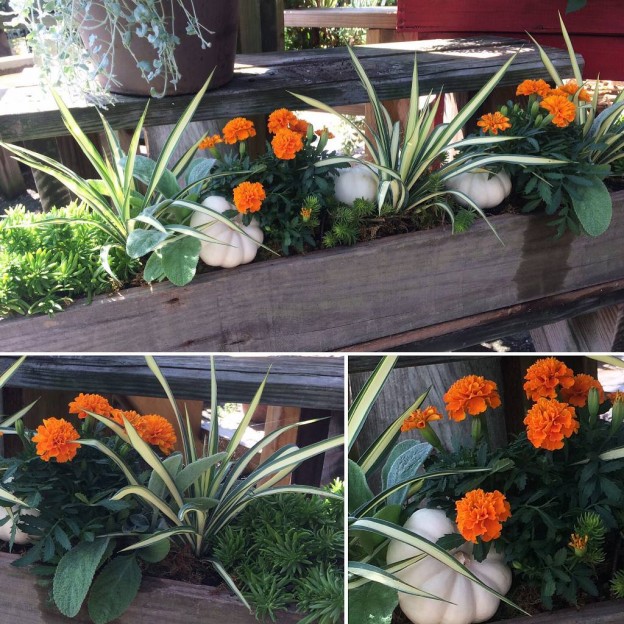
Late Summer, Early Fall Arrivals
August and September are usually hot and dry, but even so the transition into a new season has begun. Many summer garden beds are tired and planters are overgrown or just plain gone. In the nursery business we look forward to October and new offerings of plants, as well as the beauty of pumpkins and gourds. Just when we need a fresh start, it arrives with new selections for the autumn plant palette, mums, marigolds, and in October the first of the violas and pansies.
Marigolds come in all sizes, from tiny 4″ pots perfect for tucking into tired pots, to 10″ offerings big enough to fill a planter all on their own. Mums covered in buds come in 8″ and larger pots, in many colors and make a big statement where it’s needed. Be sure to handle them gently, as bud laden stems can break easily. Mums and marigolds aren’t available for long, but they offer transitional color and still allow you to plant pansies and violas when the weather is cooler.
More herbs will fill the nursery as well, including rosemary that will carry on through the winter. Curly parsley is beautiful in winter beds and planters, and soon ornamental and edible kale, and mustards will appear also. Late summer brings perennials too. Have you tried heuchera in the garden or pots? They’re beautiful in part sun or full shade. Just be certain not to over water.
The greenhouse goes through transitions too. From succulents to many types of ferns and more, the amount of plants stays constant, though the variety changes with availability. So if your plants need refreshing with the new season, come take a look!
If you follow us on Instagram or Facebook you’ve probably seen a new series of shop videos – if not, follow us and check them out! They’re also on our YouTube channel under Oak Street Garden Shop – if you’d like to see more, subscribe!
By Kris Blevons
Air Plants (Tillandsia) – What You Need To Know To Grow Them!
Tillandsia or air plants, are very cool indoor plants and the largest genus in the bromeliad family. They’re considered epiphytes, absorbing moisture and nutrients through the air, using plants or other structures as support.
Like other bromeliads, their life cycle ends after blooming, but new plants, called pups, form around the base of the plant. They do not require soil to live – the roots help them to attach to a host, whether it be on a plant, tree or piece of wood. They are not parasitic, meaning they won’t harm the host plant, rather, they use it as a support, taking nutrients from the air and water you supply.
.
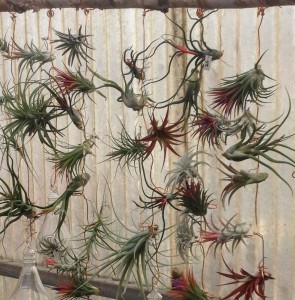
hanging air plants…
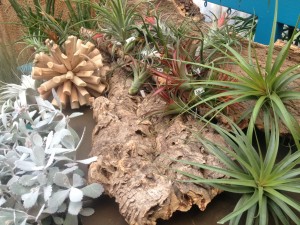
air plants – we think they will look great attached to the bark pieces here!
There are tillandsias with rather stiff, gray or faded leaves and those with softer, greener foliage. As a rule, the stiffer leaved, gray ones will need more light but less water – and those with softer, greener leaves tolerate lower light levels but appreciate more moisture.
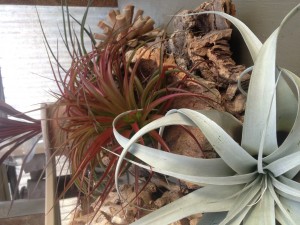
look at the contrast in colors here!
In their native habitat, tillandsias live on trees, so they get light, but it’s diffused through the canopy. Try to emulate this in your home, giving them strong, but indirect light (not right in a window, as that could burn the foliage and cause it to dry out faster too) or place them outside through the summer, in a shady spot, or at most a location with morning sun and dappled light.
As noted, the gray leaved tillandsias need less water than the softer leaved green ones but when you water ((roughly once a week), take them to your sink and water thoroughly, shake the excess moisture off (you don’t want water ever sitting in their base) and return them to their home. They need to dry out between watering. If they get too dry, they’ll have curled or rolled leaves that look shriveled – you don’t want them to get to that point!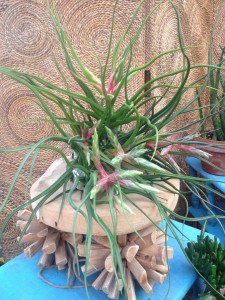
If you display them outside, bring them indoors for the winter when temps drop below 40 degrees. Don’t worry about fertilizing – they are susceptible to over feeding – best to leave well enough alone!
Stop in and take a look at these cool plants – we’re sure you can find somewhere to try one or two – they’re too fun not to!
If you follow us on Instagram or Facebook you’ve probably seen a new series of shop videos – if not, follow us and check them out! They’re also on our YouTube channel under Oak Street Garden Shop – if you’d like to see more, subscribe!
By Kris Blevons
Bromeliads – Colorful And Easy Tropicals For Your Home…
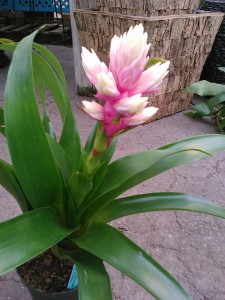 You’re no doubt familiar with the brightly colored bracts and strap-like leaves of bromeliads. Extremely long lasting and colorful alternatives to orchids and other flowers, they can’t be beat for a touch of tropical beauty and their ease of care in our homes and offices.
You’re no doubt familiar with the brightly colored bracts and strap-like leaves of bromeliads. Extremely long lasting and colorful alternatives to orchids and other flowers, they can’t be beat for a touch of tropical beauty and their ease of care in our homes and offices.
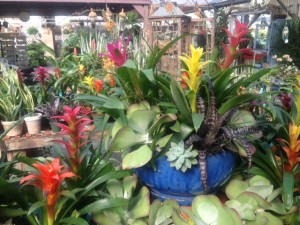
bromeliads brighten the greenhouse…
These bright plants are distinguished by their rosettes of leaves – the most famous of the bromeliads is the pineapple. Bromeliads can be found growing in the wild from Florida and the West Indies to Mexico, through Central and South America. They’ve adapted to a wide range of growing conditions, though, from tropical rainforests to elevations as high as 11,500 feet in the Andes Mountains.
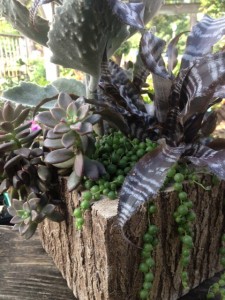
cryptanthus and succulents…
The majority of bromeliads are epiphytic, meaning they grow on trees but don’t take nutrients from the tree itself, rather from the moisture in the air – the tree is just a means of support. Another member of the bromeliad family we carry is cryptanthus. It is a terrestrial, growing on barren, rocky soil. Cryptanthus are found in the cloud forests of Ecuador, surviving on the moisture from the clouds that envelope them. The dark leaved and silver/gray bromeliad-like plant we’ve had all summer is a cryptanthus called ‘Black Mystic’, and it is beautiful and easy to grow!
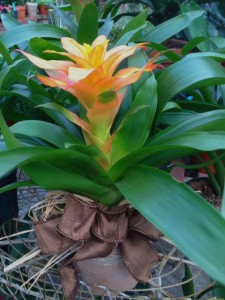
bromeliads make great gifts…
It’s fascinating to find out the native habitat of many of the plants we use in our homes and offices – but understanding where these plants come from originally can also help us better understand how to take care of them.
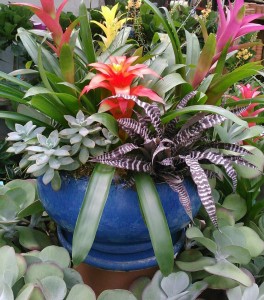
bromeliads, cryptanthus and succulents in a pretty blue bowl…
We hose down our bromeliads in the greenhouse when they’re very dry… if you’d like to more closely mimic the natural conditions of the bromeliad in your home (minus the hose!), let tap water sit for a few days so the chlorine and fluorine dissipate. Pour into the “cup” of the bromeliad and freshen the water periodically, allowing the water to flow over the cup and into the soil. Now that you understand the natural growth of bromeliads, you can see why it’s important not to overwater them.
Allow them bright light inside or place them outside on a patio or porch through the summer to enjoy these bright beauties!
We have a video on bromeliad care on Oak Street Garden Shop’s YouTube channel. If you enjoy it, subscribe for more!
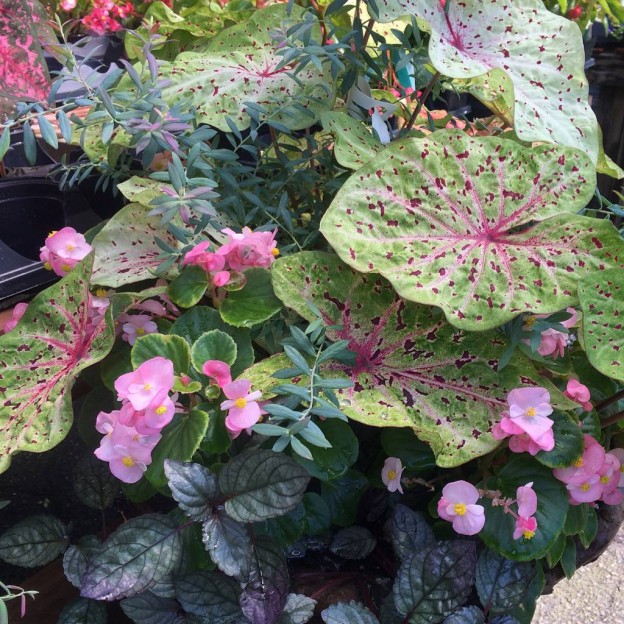
Container Gardening Design Tips
 Spring is for planting in the garden and in pots. Flowers, herbs, perennials, shrubs, and vegetables are all players in the annual game of “What will grow in this spot?” or “What can I plant in this pot?”.
Spring is for planting in the garden and in pots. Flowers, herbs, perennials, shrubs, and vegetables are all players in the annual game of “What will grow in this spot?” or “What can I plant in this pot?”.
Now that summer is here though, the pace is slower with fewer questions as more people slowly stroll the nursery for pleasure, picking up the odd plant here and there or gathering more varied selections for filling in garden spaces that need extra color.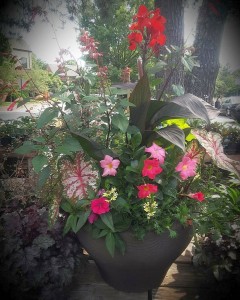
 Many of them come to see the planters we’ve put together, getting ideas for extra pots or to make note of a different combination of plants they might not have thought of.
Many of them come to see the planters we’ve put together, getting ideas for extra pots or to make note of a different combination of plants they might not have thought of.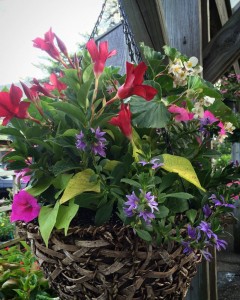
We enjoy this time too (Since we’re all pretty much plantaholics!) and look on it as our play time with plantings, a reward for making it through another hectic spring season.
So, while our neatly lined tables are still filled with a good assortment of varied plants, you’ll also find our container plantings in various spots throughout the nursery too.
Some find their way onto our Facebook and Instagram pages, others make their way to new homes. Wherever they end up we hope they give you as much pleasure as they’ve given us creating them.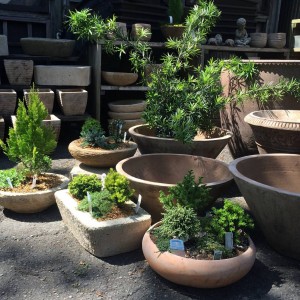
Container Gardening Tips:
Know your light. Plants that want sun won’t perform well in shade and vice versa.
If you want a pot filled only with flowers, choose blooms with different shapes for added interest. An example: A spiky salvia, rounded blooms of zinnias, flatter blooms of lantana.
Make it even more interesting and add a foliage for additional texture or color. Begin by choosing it, then add some flowers to compliment the color or shape of the leaves. An example: A spiky grass, a round pentas, an airy euphorbia, a trailing vinca.
Bigger planters call for bigger plants. Use at least one eye catcher or “thriller”. Add intermediate or “filler” plants, then complete the picture with a trailing or “spiller” selection. This is the tried and true Thriller, Filler, Spiller recipe. It never fails. An example: A black elephant ear (thriller), sunpatiens (filler), scaevola (spiller).
Think about the setting the planter is in. What color is your house? What trees and shrubs will be in bloom at various times? Do you entertain at night? What are your favorite colors? Are you there to maintain and water regularly?
No matter how small your planting starts out, with proper care it may grow to enormous proportions. Be prepared to deadhead faded blooms at least weekly and clip back your planting as needed.
If you follow us on Instagram or Facebook you’ve probably seen a new series of shop videos – if not, follow us and check them out! They’re also on our YouTube channel under Oak Street Garden Shop – if you’d like to see more, subscribe!
By Kris Blevons
Don’t Stress If A Plant Is An Ugly Duckling – Imperfection Can Be Beautiful Too!
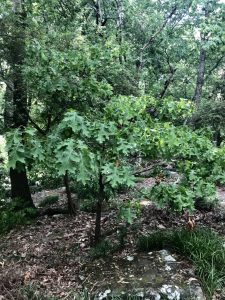 I have a tiny oak tree out back that used to be on its way to attaining an impressive size – until Hurricane Ivan hit and toppled a huge hickory tree onto it, effectively topping it.
I have a tiny oak tree out back that used to be on its way to attaining an impressive size – until Hurricane Ivan hit and toppled a huge hickory tree onto it, effectively topping it.
I know I should have taken it down when the tree company came to clear out the downed hickory, but I couldn’t do it. I liked that little oak, and over time it’s become my crazy tiny oak tree up in my rock outcrop – a hurricane survivor.
I was working up around that oak this morning, cutting a few dead branches out of it and wondering at its tenacity. Below it, also improbably growing in the rock outcrop, is a shrub called Thujopsis dolobrata – a prized specimen I planted years ago.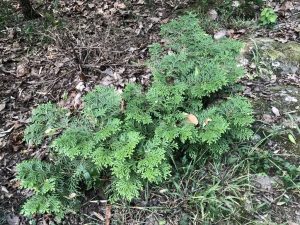
Unfortunately the Thujopsis started dying one summer, a victim to the previous fall’s drought. I watched anxiously as branch after branch eventually turned brown and died.
Unbelievably, about a third rallied and is still alive. I cut out the dead and now have half a shrub under my dwarfed oak tree. What a pair of misfits in the garden!
My imperfect garden might not be to everyone’s taste; but I’d rather have a little imperfection than everything being “just so”. A friend in the horticulture profession said it well:
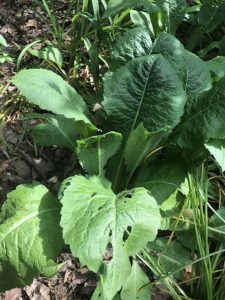 “Plants are living things like humans. They need water and sun and some need food and each grow in different ways. That yellow leaf at the bottom of the dracaena doesn’t mean that there is something wrong or that the plant is dying – it’s just a natural part of the life cycle. People need to understand that imperfect is beautiful.”
“Plants are living things like humans. They need water and sun and some need food and each grow in different ways. That yellow leaf at the bottom of the dracaena doesn’t mean that there is something wrong or that the plant is dying – it’s just a natural part of the life cycle. People need to understand that imperfect is beautiful.”
My physically imperfect tree and shrub were caused by events out of my control – a hurricane and a drought. Other imperfections are simply part of a plant’s life cycle, yellowing leaves, and damage caused by insects or animals.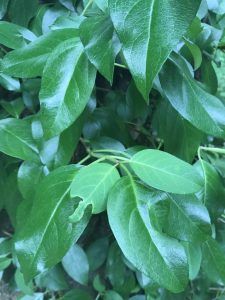
While it’s important to maintain a healthy landscape, it’s also important to know when to relax and appreciate that some imperfection is normal and not always cause for immediate alarm.
With proper watering, fertilizing, pruning and general maintenance, your plants will be better prepared to weather anything nature throws at them – and you will too.
By Kris Blevons
The Pollinator Garden Is Showing Off!
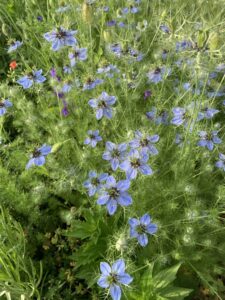
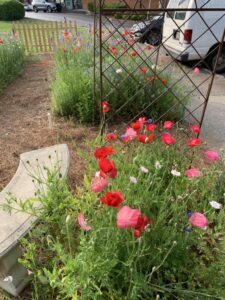 The pollinator garden is buzzing with life! We thought you’d like to see a few pictures. Remember, poppy, larkspur, bachelor button, and sometimes nigella seeds are available in the fall, and for a beautiful early summer garden sow them in November, December or even as late as January. They need cold soil to germinate well.
The pollinator garden is buzzing with life! We thought you’d like to see a few pictures. Remember, poppy, larkspur, bachelor button, and sometimes nigella seeds are available in the fall, and for a beautiful early summer garden sow them in November, December or even as late as January. They need cold soil to germinate well.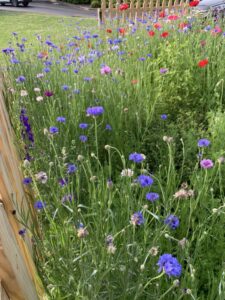
Enjoy!
If you follow us on Instagram or Facebook you’ve probably seen a new series of shop videos – if not, follow us and check them out! They’re also on our YouTube channel under Oak Street Garden Shop – if you’d like to see more, subscribe!

